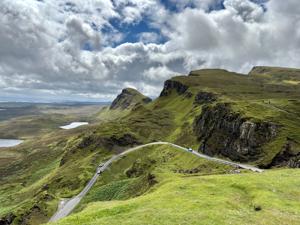
My siblings can always be counted on for “a good blether,” a chat filled with laughs. So I knew that leading them all over — on our own ambitious, weeklong, multi-city tour to reconnect with our family roots — would be easy fun. Even though we are fourth-generation Canadians from Manitoba, with no known relatives in Scotland to visit, we were excited to learn more about our heritage in a place dense with history.
As the most well-travelled, I became the tour guide by default for our group of seven, which included my partner, Tim; my brother, Brad, and his wife, Heather; my sisters, Ann and Pat; and Pat’s husband, Eugene. The last time we travelled together was on a 20 years ago. My siblings are snowbirds who winter in the U.

S., but they haven’t travelled to much, and this was my sisters’ first visit to the U.K.
In the lead-up to the trip, I couldn’t help but worry over the “what ifs,” envisioning all manner of travel mishaps — one of us tumbling down the rocky moors, say, or getting pickpocketed, lost or ill. We are not the healthiest bunch, ranging in age from 57 to 75. Writer Doug Wallace (far right) with his siblings, Brad, Pat and Ann, at the National Wallace Monument.
When my siblings arrived in Scotland a couple of days before I did, our WhatsApp group chat was a flurry of questions that didn’t put my mind at ease: “Did you see Pat get on the train?” “I think I can see Eugene’s hat ...
” Only later did I learn that my siblings were merely winding me up — as siblings do. When we were finally all together in Edinburgh, we got our bearings in the easy, intro-to-sightseeing way: on a hop-on/hop-off tour bus. The best stop of the day was the , once the floating palace of Queen Elizabeth II.
Audio guides led us through the main quarters, dining rooms and officers’ bunks, and even into the laundry room. Noting the rather spartan interiors, we determined that the Queen was not as fussy as we thought — until we came to a room that housed only silverware. We continued our exploring at the — the name alone making it irresistible for us Wallaces, despite no ancestral connection (as far as we know).
The 19th-century landmark, in the nearby city of Stirling, honours the famed Scottish knight William Wallace. It is mainly a tower with a skinny spiral staircase, broken up by three exhibition galleries. We were almost taking bets on how far up Ann would get, as she uses a cane.
Defying expectations, she managed all 246 steps — and bought the fridge magnet to prove it. The views at the top, including that of the battlefield of Stirling Bridge, stunned us into silence. This is where “Uncle Bill,” as we call him, bested the English army in the 1297 victory that made him a Scottish hero.
We left loaded up with glossy Wallace booklets. The view from the National Wallace Monument, one of Scotland’s most distinctive landmarks. Later at dinner, I was reminded that my siblings are creatures of habit.
Bellies start to rumble at noon, supper is 7 p.m., and everyone is in bed by 10.
A dinner reservation I made for 8 p.m. raised sideways glances and talk of hiatal hernias.
Though not used to ordering outside their comfort zones, they warmed up to haggis (“Actually delicious!”) and neeps and tatties (“What? Together?”), yet steered clear of “weird stuff” like blood pudding. I should have known better than to take Western Canadians to a steak house, where they looked on in silent mockery while a server explained the different cuts of beef on a wooden platter, before giving everyone their choice of knife from a velvet-lined box. Brad chose a cleaver to go with his burger.
“We can do this at home” was the restaurant review, though the plates of beef Wellington were empty at the meal’s end. Next on our itinerary was a four-day drive through the Scottish Highlands — taking in Oban, the Isle of Skye and Inverness — with R.J.
, our guide from , keeping us entertained. His tales of fairies, folklore and geology filled our heads with history and our phones with hundreds of photos. You cannot take a bad picture of this place, even in the rain.
A walk through revealed the 5,000-year-old Temple Wood Stone Circle, and a collection of grave slabs that date back to the 13th century. The region is Scotland’s densest prehistoric landscape, rich in archeological artifacts. We strolled the graveyard, Heather finding surnames that are pretty much the same as the phone book back home.
At the visitor centre within the , we communed with a few “hairy coos” (the Highlands’ adorable shaggy cows) before ducking into a sod hut that reminded us of the one that our great-grandfather Wallace reputedly built when homesteading our family farm in 1879. One of the “hairy coos” — the Highlands’ adorable shaggy cows — at the Glencoe National Nature Reserve. By this time, I had stopped worrying about whether my family was having fun — we clearly were.
They all knew how to order lunch right from the bartender, navigate their way around a pay toilet and instruct a cab driver from the sidewalk before getting in. We were getting on swimmingly. “Let’s make tonight a quiet night” was my code for: I’m taking the night off, and you can find supper where you find it.
I had researched a few pubs that feature traditional Scottish live music — music has always been a big part of our lives, thanks to the talents of our mother — yet we couldn’t seem to stay up late enough to enjoy it. In Oban, we did manage to find chairs at a ceilidh — a folk music community get-together — but it was more of a dance class. “Lotta left feet out there,” Pat said.
“There’s £10 I’ll never see again,” Tim said. “At least the drummer was easy on the eyes,” Ann added. I began to see why I have become so judgy in my old age — it has merely rubbed off.
On the overwhelmingly beautiful Isle of Skye, R.J. whisked us along tiny villages and lush valleys, rocky cliffs and high plateaus.
Each stop had us drinking in the scenery, supported by a dram of whisky every now and then. My siblings are not huge drinkers (anymore), but Eugene is the Scotch fan, so a dip into the saw us nosing several samples and passing them around, smacking our lips. The was our last major stop, the site of the final 1746 battle between the Jacobite army and the (victorious) British forces.
The museum here is one of the best I have ever encountered, whether any of my kin are buried outside under the “Mixed Clans” markers or not. That Culloden is featured in the TV show “Outlander” was not lost on my family. When we stopped at the nearby , a prehistoric burial site with one stone credited as the inspiration for the show’s fictitious stone circle, we admitted to feeling like we were travelling back in time, too — going back to our roots.
In the end, despite all my pre-travel trepidation, no one tripped down the moors or hurt themselves. Ann’s blood sugars got a little low one day, but she rebounded. No one got lost, and no one left their passport in the hotel safe — my work here is done, I thought.
The holiday absolutely flew by, one we’ll probably blether about for years to come..














